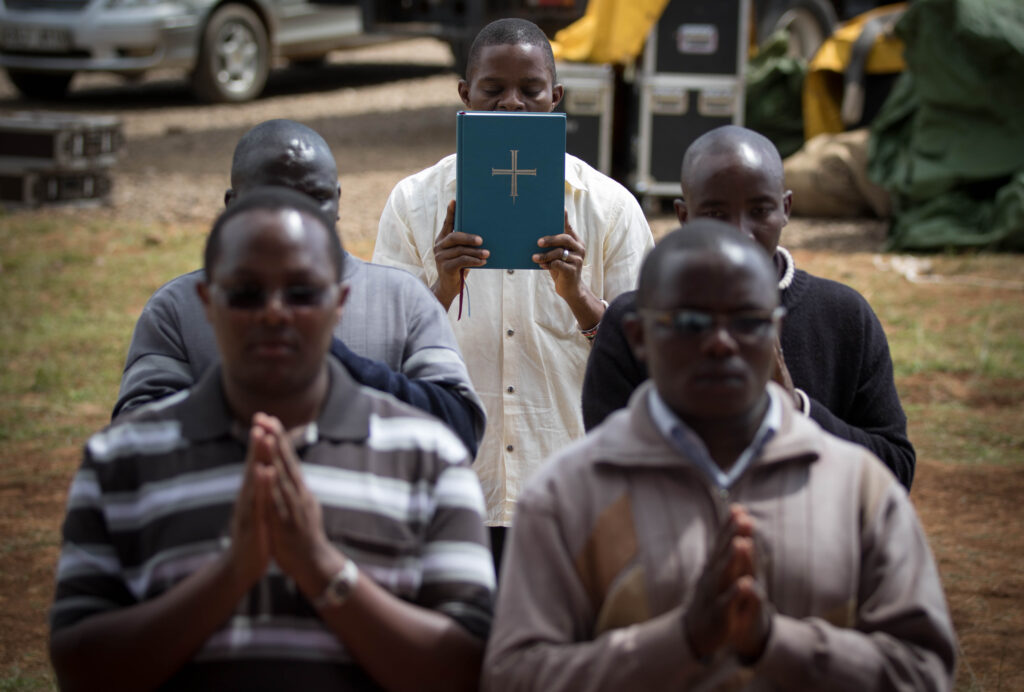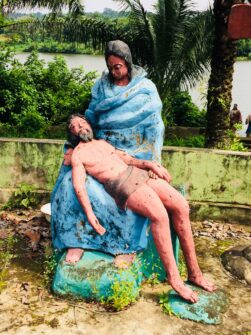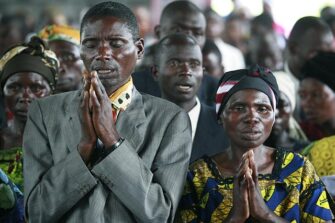
Emmanuel Katongole’s Who Are My People?: Love, Violence, and Christianity in Sub-Saharan Africa explores the question of African and Christian identity through a rich blend of theory and storytelling. While Katongole touches on prominent themes that drive his previous work, such as violence and Christianity on the African continent, his new book approaches these issues in a fresh way through explicitly centering the theme of identity through the question: who are my people? Katongole’s answer emerges through explorations in philosophy, literature, and the stories of individuals and communities in the Central African Republic, Rwanda, Burundi, and Benin. In this post, I will attend to Katongole’s discussion of identity through three dimensions of the book: (1) the structure of the work, (2) the thematic exploration of wounds, and (3) the genre of the sermon. Alongside this exploration of identity in Katongole’s work I will also consider the important contributions Katongole makes to the method of portraiture and the role of friendship in social and political transformation.
Structure and Methodology: Considerations of Identity
Those familiar with Katongole’s work will have encountered his method of theological portraiture, which he develops by drawing on the work of Sara Lawrence-Lightfoot and Jessica Hoffman Davis, who describe portraiture as an approach which blends aesthetics, the social sciences, and ethnographic methods to prioritize attending to goodness—without excluding critique—in regards to their subject. Like an artist painting a portrait, portraiture is attentive to how research is communicated, emphasizing the importance of integrating an artistic dimension into academic writing. In Who Are My People? Katongole uses portraiture in two distinctive ways: (1) by taking up narrative portraits of exemplary individuals to communicate theological meaning, and (2) by incorporating his own narrative into these portraits. The distinctively theological dimension of Katongole’s use of portraiture will be taken up in the next section. Here, I would like to comment further on Katongole’s use of his own story in the text and how this impacts the structure of the text.
One of the challenges of engaging in both complex theoretical discussion and attending to the stories of exemplary individuals is avoiding the pitfall of a strict division between theory and experience, in which the initial articulation of theory is presumed to shape practice, rather than theory and practice mutually informing one another. Katongole avoids this potential shortcoming in the way he integrates his method of portraiture, creatively incorporating his own personal narrative and journey throughout the book as a whole. While the book is divided into two parts, the first attending to philosophical and theological considerations of identity and the second focused on exemplars, in part one we do not simply encounter the theoretical underpinnings for his exploration of identity in Africa, we meet Katongole in 1994, as a student in Leuven, Belgium and follow him on his philosophical and theological journey as he seeks to understand what it means to be African and Christian in his own life.
What strikes me is that in this first section we encounter, for the first time in Katongole’s writing, a theological portrait of himself. This portrait emerges in small sketches, short narratives, and brief moments of internal reflection that begin in part one as he invites us into his own intellectual journey from Valentine Mudimbe’s The Invention of Africa: Gnosis, Philosophy, and the Order of Knowledge to Virgilio Elizondo’s concept of mestizo identity in The Future Is Mestizo. Katonogle’s journey continues in part two as he encounters people whose lives exemplify love’s reinvention in the midst of Africa’s modernity: the reinvention of identity with Maggie’s Maison Shalom in Burundi, the reinvention of politics in the Central African Republic with organizations like Fr. Kinvi’s mission hospital, and the reinvention of relationship to the land at Songhai Center in Benin.
The result is that Katongole situates his philosophical and theological foundations in a concrete location—the context of his own life’s journey. It also means that theological portraiture underpins the work, including his more theoretical reflections. In other words, bringing in pieces of his own story into the method of theological portraiture allows for theory to be embedded in experience and narrative from the beginning of the book. The ways Katongole integrates his own narrative in the most theoretically dense sections of his work breaks with a conventional style of academic writing, which often ignores or only addresses in a superficial way how the author’s personal experience concretely shapes their engagement with theory. In experimenting with portraiture in this way, Katongole provides a creative example for how academics can concretely integrate experience into their work, allowing experience to inform all elements of their project.
Portraiture and Identity as Theological: An Exploration of Wounds

As in his previous work in The Sacrifice of Africa: A Political Theology for Africa and Born from Lament: The Theology and Politics of Hope in Africa, in Who are My People? Katongole draws our attention to the way extraordinary acts of love emerge in unlikely contexts of immense suffering and violence. In Who Are My People? Katongole uses the imagery of wounds. From the wounds of colonialism that laid the foundations for the wounds of genocide in Rwanda, to the wounds of a polluted earth, wounds are a recurring image. In the chapter titled “Conclusion: The Logic of the Cross” he explicitly connects this image to the logic of the cross in order to explore this intersection of love and suffering in a distinctly theological modality—providing the theological dimension of his theological portraiture. Throughout the book we see the various ways people can respond to wounds either by participating in the cycle of violence and exclusion or with an excess of love that breaks with this cycle. It is to these second set of responses—those grounded in love—to which Katongole is particularly attentive. We see examples of such responses in Fr. Godfrey Nzamujo at Songhai Center seeking ways to heal the earth and in Maggie’s Maison Shalom in Burundi seeking to heal the divisions between Hutus and Tutsis. Each of these portraits, in some way, participates in the excess of love represented in the wounds of Christ. In each story, there is an encounter with suffering and death out of which springs—despite the seeming impossibility—new life.
Here, feminist and womanist theologians who address the issue of suffering in the Christian tradition could be fruitful dialogue partners. Many feminists and womanists critique the ways in which valorizing suffering as salvific can be used to silence voices that resist injustice and justify the status quo. Yet, within this discourse there are a variety of responses to the suffering of Christ and the cross. For womanist theologian Delores Williams it is ultimately Jesus’ life as a whole, which exemplifies a commitment to working against injustice and solidarity with the oppressed that is salvific, not his suffering and death. On the other hand feminist theologian Dorothee Sölle identifies Christ in the person at the margins who is suffering like Christ on the cross, and womanist theologian Shawn Copeland argues that the dangerous memory of the cross —a concept drawn from Johannes Baptist Metz—must not be neglected. Copeland explicitly connects the suffering of Jesus to the suffering of Black women’s bodies in the context of slavery in the U.S. Despite differences in the specifics of their theological approaches, what these feminist and womanist theologians share is a commitment to justice realized through solidarity that confronts unjust political regimes in order to transform oppressive conditions. As Dorothee Sölle argues in Against The Wind: Memoir of a Radical Christian, “I must say first: God is Justice. To know God means to do justice” (116).
Feminist and womanist theologians would be enriching dialogue partners for Katongole’s work because of their shared commitment to prioritize voices from the margins and their shared aim of transforming systems of violence. Importantly, Katongole’s theological portraiture is careful not to misuse stories of hope to justify or diminish suffering. Rather, Katongole responds to oppressive political and social realities through stories that invite us to recognize that another way of doing things—another world—is possible even in the midst of violence and suffering. One place feminist and womanist interlocuters might expand Katongole’s work is with regards to the role of justice in creating new communities of belonging—a topic Jason Springs points out in his post for Contending Modernities Katongole does not engage in-depth. I think underlying the affirmation from feminist and womanist theologians that “God is justice” is the claim that one of the ways we honor that the image of God is in each one of us is through holding one another to account when there is a failure to uphold an individual’s or community’s dignity. The demand for justice is not eclipsed by love—though the ultimate end of justice refracted through practices of forgiveness and love is restoration and transformation, rather than retribution. Here, I would like to raise the question: How does a theology of justice intersect with the “excess of love” Katongole emphasizes in Who Are My People? One way to answer this question would be to take one of the portraits in Katongole’s book, such as his exploration of healing and creating a new community after the genocide in Rwanda and Burundi though the lives of Father Jean Baptiste Mvukiyehe and Maggy Barankitse, and explore where God’s justice fits within their lives and work as well as how justice and love mutually shape each other in these contexts.
The Genre of the Sermon: A Call to Transform Identity through Friendship
Katongole chooses to end his book with an afterword in a genre that is not typical in academic work: a sermon. His choice to conclude with a sermon is fitting for two reasons. First, a central thread that runs through the book is Katongole’s own journey. Most of what we encounter in earlier sections of the book are Katongole’s intellectual explorations of identity prompted by the Rwandan genocide, vignettes of the different geographical locations Katongole has lived and worked in, and reflections on identity that are raised in response to the exemplary individuals he encounters in the second half of the book. Yet, another component of Katongole’s identity is his negotiation of being both an academic and priest. We get a brief glimpse into Katongole’s identity as a priest in Chapter 2, when he shares that at his ordination his Muslim teacher, Elias, presented him to the bishop alongside his mother. However, Katongole as priest largely recedes into the background until the sermon that appears in the Afterward. In these final pages we encounter Katongole negotiating what it means to be a Catholic priest in the ecumenical context of his work at Duke University (2001–2012), which has Methodist roots and students and faculty from a wide variety of protestant denominations. Here, he encounters a different wound—the history of division in the Church. This leads to an expanded understanding of identity—to a new sense of “we”—that embraces the gifts of ecumenism. For Katongole, this extension of identity happens in and through unlikely friendships in our midst that trouble and expand our sense of self.
Second, concluding with a sermon can also be understood as an invitation to readers to consider his book not only in terms of its intellectual implications, but also in terms of its spiritual and practical implications. Katongole has shared his own journey towards a new sense of “we” and now his readers are invited to reflect on our own identity. Importantly, in the pluralistic context of modernity, reflecting on our own journey will not mean replicating Katongole’s particular journey navigating his African and Christian identities. Rather, it means critically reflecting on what makes up our own identity, what religious or spiritual sources we draw on, where we draw boundaries between ourselves and others, and how the expression of our identity might unwittingly participate in violence.

In the final paragraph, Katongole addresses us, exhorting, “This Odd God who became our friend invites us—nay, pushes us—into strange places and friendships, friendships that are not supposed to be. Through these odd friendship, and only through them, can we get a glimpse of God’s exciting new future…” (187). Katongole’s call goes beyond the intellectual exercise of talking across disciplines in the academy. Here, there is an invitation to us to embrace friendship—the concrete sharing of life with the other—with those who we do not usually consider to be “our people.” For Katongole it is ultimately through these concrete relationships that our identity can expand to embrace a new sense of we, a new sense of belonging, and that genuine transformation can become possible.
Not every reader will identify with Katongole’s Christian articulation of God’s call to friendship across divisions. In this regard, it is important to consider that Katongole is writing as a Christian theologian about his own specific journey as an African Catholic coming to this realization. Here, I would encourage readers from other religious traditions and cultural backgrounds to ask how their own tradition and culture might envision such a crossing of boundaries through friendship and where there might be both productive sites of resonance and disagreement with Katongole’s claim.
Through utilizing portraiture in a theological modality, Who Are My People? explores the intersection of theory and experience to address the question of identity. Ultimately, the identity Katongole describes is not static but a journey, and it is not the identity of an autonomous individual, but one formed through relationships. Katongole’s final reflections on friendship challenge us to move beyond mere intellectual considerations of identity and call for concrete action to build relationships across the boundaries that typically divide us. Engaging with Katongole’s book from my own context studying theology in the U.S., I would like to raise one final question: What would universities look like if academics and students had a sustained commitment to building genuine friendships across ideological lines (both inside and outside the academy), keeping in mind that Katongole does not view these friendships as maintaining the status quo but rather as radically transforming both ourselves and our society?

